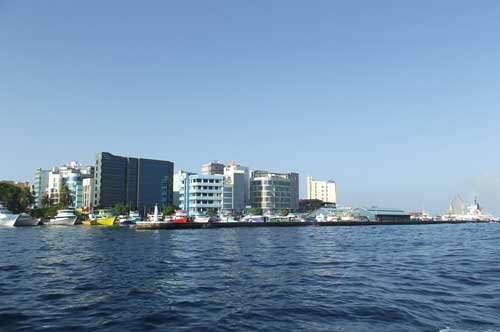The Maldives business climate maintains optimism
 By Srimal Fernando
By Srimal FernandoAsia Correspondent for Foreign Exchange
The Indian Ocean islands of Maldives is an amazing country to visit for its contrasts, high cultural interest and for its extraordinary scenic beauty. The double chain of twenty six natural ring-like atolls stretching in a north-south direction off India’s Lakshadweep islands is situated 500km from the Southern tip of both Sri Lanka and India and comprises 1190 coral islands.
The country, with a population of nearly 330,000, still remains one of the smallest independent nations in Asia. The people of the islands are widely dispersed across the atolls, in about 200 inhabited islands. The 1.77 square km. capital city Male is located at the southern edge of North Male Atoll, known as Kaafu Atoll. One third of the country’s population is located in this island.

Today the city is a bustling, rapidly developing place full of traffic and crowds. For centuries it has been a place of cultural and historical importance. The city has preserved its beautiful surroundings, spectacular architecture and its cultural values. Male is dotted with dozens of mosques having sprawling complexes with towering minarets. There is no end to the breath-taking sites visitors can see in the capital city of Male. Of the most exotic popular places of interest is the iconic 350-year old mosque known as Hukuru Miskiiy, the National Museum of Maldives, the republic square or Jumhoorie Maidan, Mulee Aage built in 1906, the mausoleum tomb of Mohammad Thakurufaanu and the Friday Grand Mosque.

Apart from the tourist attractions in the city is the well-known educational institution, the Maldives National University inaugurated last year in Male. The opening of Male International Airport in 1981 on adjacent Hulhulae Island which includes a seaplane base and a domestic base for internal transportation was an important landmark in the Maldivian travel industry. Today the Ibrahim Nasir International Airport or the Male International Airport is a major stopover point for many international and domestic airlines.
The Maldives is not just admired for its beauty but also known for its development among the South Asian countries. The story of the country’s economic success began when the Maldivian government implemented economic reforms beginning in 1989. Past and present governments of Maldives took an active role in guiding the nation’s economic development process forward.
At present the country is showing the results of its trade reforms and other liberalization measures taken several decades ago. Today the predominantly former fisheries based Maldivian economy has shifted towards a tourism based economy after a robust growth in the past few decades. According to “Ease of doing business 2012” the annual flagship publication of the World Bank, the country is ranked 79th out of 183 economies.


The economy of the country is heavily dependent on tourism and on the fisheries sectors. The Maldives Central Bank, the Maldives Monetary Authority (MMA), forecast an impressive growth figure of 5.5 percent for 2012. The tourism sector, known as the growth engine of the Maldives, has made significant headway into the world tourism markets. The country is emerging as a strong tourist destination with the number of visitors to the country climbing to 458,068 tourist arrivals from January to June 2012. According to the Maldives Marketing & Public Relations Corporation (MMPRC), tourist arrival figures shows that the country’s tourism sector grew better-than-expected with an average annual economic growth rate of 2.3 percent compared to the same period in 2011. Currently, European tourists are the number one market for the tourism industry in the country. The country’s tourism infrastructure is relatively advanced with almost 100 high standard island resorts. The sector provides job opportunities to the vast majority of the people in the country.

Historically fishing is the main traditional livelihood of the Maldivians. Of the fish caught sixty percent is skip jack tuna. Maldives Industrial Fisheries Company (MIFCO) is playing a major role in the country’s fisheries sector development.
Other main traditional industries are boat building and handicrafts. The industrial sector provides only about 7 percent of the GDP (Gross Domestic Production). With the mechanization of the traditional sailing boat dhoani in 1974 the traditional wooden and fibre glass boat building industry had started developing .The Alifushi Raa Atoll is the most famous Atoll for building boats among the many Atolls in the Maldives.

The private sector plays a vital role in traditional areas of public investments such as transport, energy and telecommunication. Comparisons have shown that the country offers the most business friendly environments in South Asia. Foreign ownership is welcome in most areas of the country’s economy. An excellent business framework backed by the Ministry of Economic Development adds to the attractiveness of the Maldives investment climate. The people of Maldives are confident about the future and have ambitious plans, expecting that the economy will be better than it was and anticipate continuous growth in the next few years.

No comments:
Post a Comment